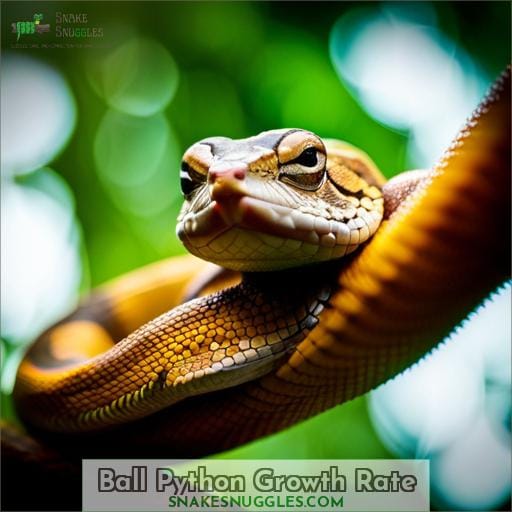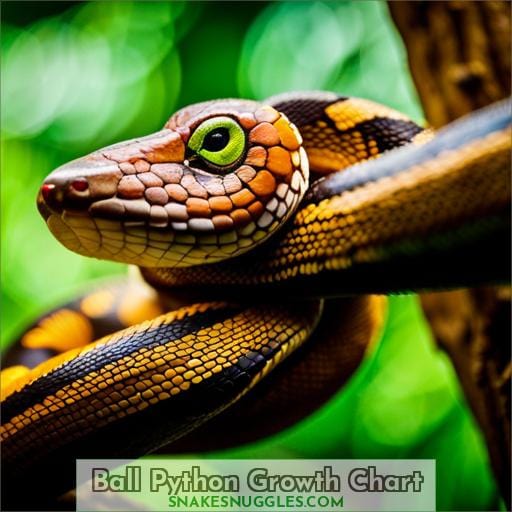This site is supported by our readers. We may earn a commission, at no cost to you, if you purchase through links.
 Are you curious about how big a ball python can grow? If so, you’re not alone. Ball pythons are one of the most popular pet snakes in the world, and they’ve earned their reputation as being docile and low-maintenance captives.
Are you curious about how big a ball python can grow? If so, you’re not alone. Ball pythons are one of the most popular pet snakes in the world, and they’ve earned their reputation as being docile and low-maintenance captives.
The answer to this question lies in understanding growth rates, factors that influence size, diet requirements and more – all of which we will explore here!
Male ball pythons tend to be slightly larger than females on average; their length ranges from two feet up to six feet long while their weight varies between 1-6 pounds or more when fully grown. Females usually reach lengths of three to five feet with weights around 2-4 pounds at full maturity.
Both sexes take approximately 3 – 5 years before they reach adult size — although genetics play an important role too! Factors like gender, enclosure conditions (temperature/humidity), genetics & ancestry determine each individual’s maximum potential size – something we’ll dive into further below.
Table Of Contents
- Key Takeaways
- Ball Python Growth Rate
- Male Ball Python’s Growth Rate
- Female Ball Python’s Growth Rate
- How Large Can a Ball Python Grow?
- How Long Does It Take for a Ball Python to Grow Fully?
- When Do Ball Pythons Reach Sexual Maturity?
- Ball Python Growth Chart
- Factors That Influence Ball Python’s Size
- How Do I Weigh a Ball Python?
- How to Avoid Obesity in Ball Pythons?
- Frequently Asked Questions (FAQs)
- Conclusion
Key Takeaways
- Ball pythons can grow up to six feet in length and weigh up to six pounds.
- Growth rates vary between genders, with females growing at a faster rate than males.
- Factors such as genetics, enclosure conditions, and diet influence the size of ball pythons.
- The growth rate of ball pythons slows down after the first four years of life.
Ball Python Growth Rate
You can expect your ball python to grow rapidly in its first four years of life, with females growing up to a foot each year and males reaching 8 inches annually until maturity.
After that, growth rate slows down considerably but size variations between genders remain; at maturity, female ball pythons measure between 4-5 feet while males are typically 2.
Genetics play an important role in the snake’s size as well as feeding habits – offering food regularly but not too much is key for optimal growth and health – as well humidity levels: they should be kept relatively low (50%-60%) so the air doesn’t become too dry or stuffy for them to breathe properly.
If you’re looking into pet adoption it’s wise to remember that these snakes have a long lifespan – up 30 years or more when taken care of properly!
In addition to providing quality nutrition, regular weighing helps track their progress over time – keeping an eye on any sudden spikes which may result from obesity rather than rapid growth – making sure safer husbandry conditions are provided along with plenty of space for exercise will ensure your pet reaches its full potential in both length and weight!
Male Ball Python’s Growth Rate
Male ball pythons generally reach sexual maturity at three years old, growing around 8 inches each year until then. Their size is affected by many factors such as genetics, temperature control, prey quality, and enclosure size.
Males typically measure between 2.5 to 3.5 feet long and weigh 2-3 pounds at this age. In contrast, females grow larger, reaching four to five feet in length, with some even exceeding 6 ft.
With proper care, including a healthy diet and adequate space for exercise, most ball pythons will reach their full potential of breeding size within the first 5 years of life. Males usually take 18 months, but females require another 6 months on top of that before hitting sexual maturity for reproduction purposes.
Living up to 20-30 years or more, these small yet friendly snakes have become increasingly popular amongst pet owners who enjoy their variety of colors and patterns, along with their docile temperament.
Female Ball Python’s Growth Rate
Female ball pythons grow at a rapid rate in their first four years, reaching near one-foot increments each year. To reach their full size potential, gender, genetics, husbandry, enclosure size, and food quality all play an important role.
Females mature faster than males. Within three months of hatching, they typically grow 1 to 2 inches longer than the males. At maturity, female ball pythons measure between 4 and 5 feet, with some even reaching 6 ft long, while weighing around 5 or 6 pounds.
This is nearly double the length of males, who usually only measure 2 ½ to 3 ½ feet when fully grown at three years old and weigh 2-3 pounds.
To ensure steady growth, it’s essential that feeding is appropriate for age, as well as maintaining correct humidity levels in the environment (50%-60%). This can be achieved using paper towels or newspaper substrate materials like Aspen bark mulch or cypress mulches combined with Orchid bark mix substrates.
A healthy balanced diet should consist mostly of small rodents such as mice. However, excessive eating habits can cause obesity if not monitored correctly. So, offer food moderation alongside plenty of exercise space inside its enclosure.
With adequate care and nutrition, these majestic reptiles will reach their physical best by five years old, making them one of the most popular pet snakes worldwide.
How Large Can a Ball Python Grow?
You may be wondering how large a ball python can grow. Male ball pythons typically measure between 2.5 to 3.5 feet long and weigh 2-3 pounds at three years old, while female ball pythons measure between four and five feet in length, with some reaching 6 ft, and weigh around five or six pounds when fully mature.
Male Ball Python’s Length and Weight
At maturity, the regal coils of a ball python can measure up to six feet in length and weigh around five or six pounds. Male ball pythons typically reach this weight range at three years old and two-and-a-half to three feet long.
Females are larger overall as they grow faster within the first four years of life with nearly one-foot increments per year. They reach sexual maturity later than males at 24 months. Genetics, enclosure size, diet quality, and food amount all influence their growth rate.
Offering them ample space for exercise is key for avoiding obesity, which can be mistaken for rapid growth due to similar body condition signs like lethargy or an increase in girth.
Ball pythons have become popular pets over recent decades, largely due to their small size combined with a docile temperament. This makes them easy to keep once suitable husbandry conditions are provided, along with appropriately sized prey items fed weekly.
Female Ball Python’s Length and Weight
You can expect your female ball python to reach up to 5 feet in length and around five or six pounds of weight at maturity. Female ball pythons grow faster than males within three months of hatching, with nearly one-foot increments per year.
The size difference between genders is influenced by genetics, husbandry, enclosure size, and food quality.
Maximum adult length is 182 cm (6 ft), with females slightly larger than males. Ball pythons have an impressive defense strategy; they coil into a tight ball when threatened – earning them their name ‘Royal Python’.
Feeding appropriately for steady growth and health will help ensure that your pet snake reaches its full potential in size and weight while maintaining good condition throughout its lifespan!
- Females grow 1 foot/year until age 4
- Males measure 2-3ft & 2-3lbs @ 3 years old
- Maximum adult length = 6ft
- Defense Strategy: Coil into a tight ball
How Long Does It Take for a Ball Python to Grow Fully?
With proper care and feeding, a ball python can reach its full size in just five years. This is due to the combination of genetics, enclosure size, diet quality, and regular weighing that will help it grow steadily and healthily.
Young pythons typically measure between two to three feet long for males or four to five feet for females at maturity. African pythons are known as non-venomous constrictors, which have adapted their defense strategy by coiling into a tight ball when threatened.
To ensure your snake’s growth potential is met, provide an appropriate sized enclosure with adequate space for exercise. Feed them appropriately sized rodents weekly and maintain humidity levels around 50-60% using substrates like newspapers/paper towels or Aspen/cypress mulch/orchid bark.
Regularly weighing your pet helps track their progress while avoiding obesity from overfeeding by providing balanced meals in moderation only when necessary.
When Do Ball Pythons Reach Sexual Maturity?
Unlock the secret of your ball python’s sexual maturity – males reach it at 18 months, while females do so 6 months later. Knowing when to expect this important milestone will help you understand their breeding age and mating habits in captivity.
In the wild, ball pythons can grow up to five feet long, but most stay under four feet due to food availability. They need an enclosure that is appropriate for their size and diet type. African Soft-furred Rats, Common Rats, and Striped Mice are all good choices for feeding a growing snake.
To ensure steady growth without obesity or malnutrition, provide them with plenty of space according to their Enclosure Size Feeding Chart found online or from specialist breeders/pet stores across the country.
Your ball python should have access to at least twice as much floor space as its own body length so they can exercise freely each day.
As they approach sexual maturity between 18-24 months old, make sure you feed them well-balanced meals every week, such as rodents based on weight ratios listed on trusted sources like reptile magazines or websites dedicated specifically towards caring for these snakes correctly.
Ball Python Growth Chart
Now that you know when ball pythons reach sexual maturity, it’s important to understand their growth chart. Ball pythons grow at different rates depending on genetics, enclosure size, diet, and food quality.
Male ball pythons usually gain 8 inches each year until they reach 3 years old, while females rapidly grow in the first four years with near one-foot increments per year.
At full size, an adult can range from 2-6 feet long and weigh between 1-6 pounds. However, males are typically smaller than females, measuring between 2.5 – 3 ft in length and weighing around 2-3 lbs by age three.
To ensure your snake reaches its full potential in both size and weight, provide adequate space for exercise, as well as a healthy balanced diet of appropriately sized rodents offered once a week or every other week.
Additionally, provide fresh clean water daily. Be sure not to overfeed them, though, since obesity is common among captive snakes due to mistakes in rapid growth and lack of proper care and husbandry conditions, such as humidity levels (50%-60%), which should always be maintained alongside suitable substrates like newspapers and paper towels, rather than wood chips, etc.
Lastly, keep track of your pet’s health by regularly monitoring weights, allowing you to catch any issues early on if present, while also helping accurately determine how big ball pythons can get overall!
Numeric List:
- Males measure between 2.5 – 3 ft long when mature.
- Females measure 4 – 5 ft (some reaching 6 ft).
- Weight ranges from 1–6 lbs (females being heavier).
- Maintaining proper humidity levels 50%–60%.
Factors That Influence Ball Python’s Size
You may have heard of ball pythons and their popularity as pets, but do you know how big they can get? Gender, genetics, husbandry, enclosure size, and diet are all factors that influence a ball python’s size.
With the proper care, including providing an appropriately sized enclosure with adequate humidity levels, along with a healthy diet rich in protein sources, these pet snakes can reach full adulthood sizes within five years.
Gender
You’ll notice that female ball pythons grow at nearly 1.5 times the rate of males, with females reaching their full size in just five years.
Gender roles also come into play with growth patterns. Male pythons reach sexual maturity around 18 months, whereas it takes an additional 6 months for the females before they are ready for mating rituals.
Color pattern is typically black or dark brown with light brown or gold sides and dorsal blotches.
Genetics
Discover how genetics play a role in determining the size of ball pythons and watch them reach their full potential! Genetics influence the overall size of these beloved snakes, as genetic diversity is essential for healthy growth.
Environmental impact, diet quality, and ideal python enclosure dimensions should be considered when providing care for your pet python
. Temperature control also plays an important role, alongside food quality, to ensure steady growth.
Rolled around or underground hiding places give your snake a sense of security, while easy-to-handle adults have white or cream bellies that indicate good health – all key factors in helping them grow big and strong!
Husbandry
To ensure your ball python reaches its full potential in size, proper husbandry is key. Heat regulation, feeding habits, and enclosure size are all important factors when it comes to keeping these terrestrial species as good pets.
Diet quality and temperature control should be closely monitored for small birds like mice or chicks that make up their diet.
Enclosure Size
Let’s explore how the size of your ball python’s enclosure can affect its growth! Genetic factors, food quality, and humidity levels need to be taken into account. An appropriately sized home with regular weighing will help ensure steady growth.
Humidity should stay between 50-60%, while providing adequate space for exercise is essential to avoid obesity.
Diet
You’ll be astounded by the growth of your ball python when you feed it a balanced diet! Quality food is essential for steady growth and health, with adequate space to exercise. Regulate portions to prevent obesity or overeating; this helps keep your pet in prime condition and size.
Factors such as genetics and husbandry also play key roles in how big it can get, but proper nutrition is fundamental for reaching its full potential.
How Do I Weigh a Ball Python?
Weighing your ball python is an important way to monitor its health and growth. It’s essential to use weighing scales that are accurate and provide consistent measurements. There are many measuring tools available, such as digital scales or even kitchen food scales.
Once the scale is set up correctly with your ball python on it, record the measurement so you can compare it against future weigh-ins for tracking progress over time. Remember to also take note of any changes in body condition when assessing your snake’s health.
Is its weight stable? Is there a sudden increase due to obesity? Weighing regularly helps keep track of all this information quickly and easily.
Here are four key things about weighing a ball python:
- Use accurate weighing equipment.
- Record measurements.
- Take note of body condition.
- Weigh regularly for better health tracking results.
How to Avoid Obesity in Ball Pythons?
To keep your ball python healthy and at its potential size, be sure to avoid obesity by providing a balanced diet and space for exercise – even in the smallest of enclosures! For example, one owner was able to maintain their snake’s ideal weight despite living in an apartment with limited floor space.
To make this possible:
- Provide a proper diet that is high-quality food with appropriate portions so as not to overfeed your pet.
- Ensure enough room for exercise within the enclosure; even if it’s small, you can provide logs or rocks which allow them some movement throughout their environment without too much stress on them or using up too much space available.
- Regularly weigh your pet; tracking health and growth history will offer more insight into what kind of nutrition may benefit it most along with being aware when there might be any issues like obesity arise from overfeeding/lack of activity etc.
- Maintain a healthy balance between food quality & quantity while offering more opportunities for physical activity than just sitting around all day! Doing so will ensure that you are giving both mental stimulation as well as physical fitness necessary to maintain optimal body condition in captivity rather than becoming overweight due slow metabolism rates typical among reptiles such as ball pythons.
With these steps taken, you’ll have peace of mind knowing that they are getting everything needed towards attaining their full size potential safely and comfortably.
Frequently Asked Questions (FAQs)
What is the average lifespan of a ball python?
You may live up to 30 years or more with proper care, and the record age for a ball python is over Females mature at around 4-5 feet while males typically grow to 3-5 feet; however, these majestic creatures can reach 6 ft! Anachronistically speaking, they could be considered regal pets due to their small size and temperate disposition – as well as their historical place adorning royal garb in antiquity.
What temperatures should a ball python’s enclosure be?
For optimal health, ball pythons should be kept in a temperature range of 78-80°F during the day and 70-75°F at night. Humidity levels should remain between 50 to 60%, so adding aspen or cypress mulch can help keep things balanced.
To ensure your pet’s safety, invest in an accurate thermometer and hygrometer for vital tracking.
What is the ideal humidity for a ball python?
Ball pythons prefer humidity levels of 50-60%. Providing an appropriate substrate, such as newspapers or paper towels, and offering fresh water can help maintain the ideal range.
What kind of food should I feed my ball python?
Feed your ball python a variety of small mammals and birds, such as rats, mice, and chicks. Offer food in moderation to avoid obesity; provide adequate space for exercise too.
How often should I handle my ball python?
Handle your ball python regularly but gently. Make sure to do so only after it has had enough time to digest its food, which can take up to 24-48 hours. Respect the space of your snake and handle them for no longer than 20 minutes at a time, several times per week.
Conclusion
With their friendly personalities, colorful patterns, and small size, ball pythons are one of the most popular pet snakes in the world. But how big do they get? As it turns out, the size of a ball python can range from two to six feet, with females generally being larger than males.
This growth rate is heavily dependent on factors such as gender, genetics, husbandry, enclosure size, diet, and food quality. To ensure your ball python reaches its full potential size and weight, regular weighing is important, as well as providing a healthy and balanced diet and plenty of space for exercise.
With proper care, you can ensure your ball python grows into a magnificent creature, living up to its royal namesake.
















